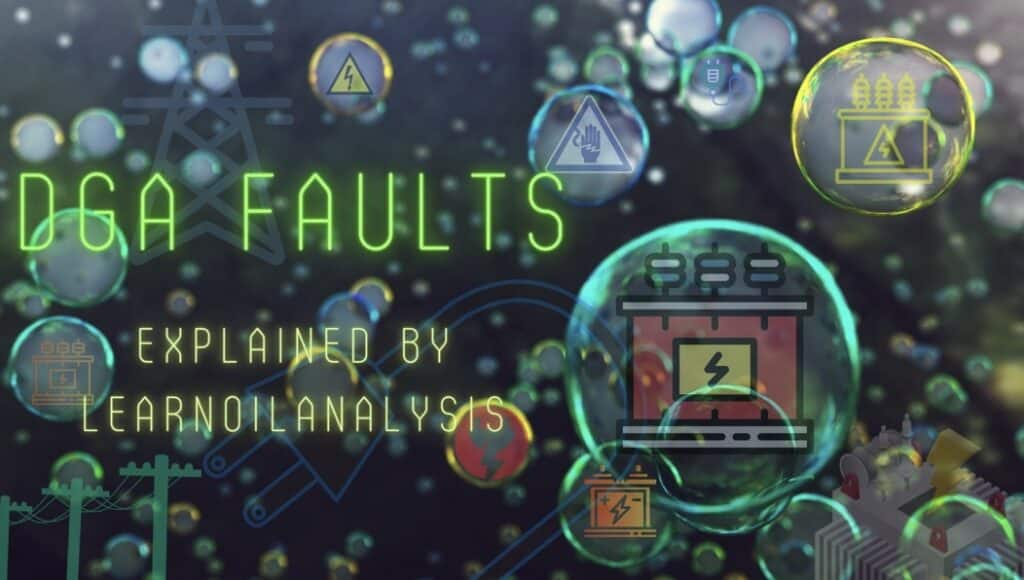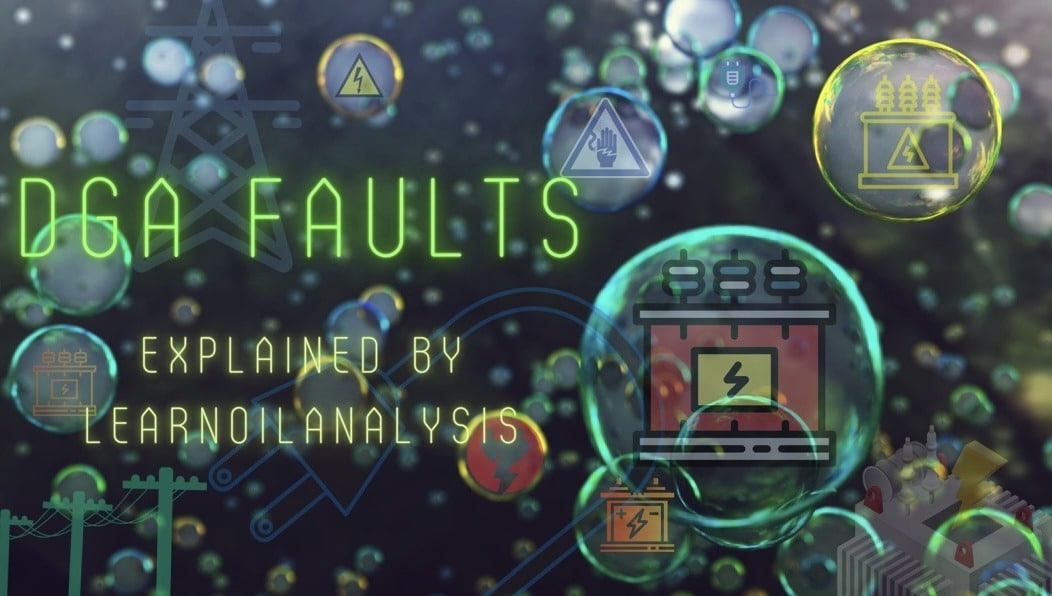
A lot of my recent posts have all been on the lube oil side of oil analysis, so today I decided to mix it up and do an electrical oils post on a topic I find the most interesting in electrical oil analysis and that is Dissolved Gas Analysis (DGA). This is an excellent technique that can identify a potential failure of a transformer up to 4 years before it occurs. Hence you can imagine it’s a pretty important test.
History of DGA
This is not a new technology and in fact, the legendary figure Ron Rogers of the Rogers Ratios used to work for my father many years ago. I was too young to be trained by him directly, but his prodigy on DGA, an electrical oils chemist called Ken Lewis who worked with Mr Rogers for many years gave me my first training on DGA interpretation when I entered the industry. The other big figure in DGA analysis is a French Canadian electrical engineer by the name of Michel Duval of Duval Triangles and Pentagons. He is exceptionally passionate about his subject area and you can read many papers he has written on the topic with a quick Google search. He was kind enough to email me my first set of Duval Pentagons that I still refer to this day untouched and even with the French excel tab names still in place.
How is dissolved Gas Analysis performed?
DGA can be performed by several techniques. The most popular uses a technology called gas chromatography to separate and identify the different gases in the insulating oil.
The interpretation of the data has many different mechanisms each with its own advantages and disadvantages. They all work predominantly on total amounts of gas and/or ratios between the gases to determine the fault. All are based on statistical data from thousands of case studies of transformer failures across the world combined with dissolved gases from the regular analysis. All these different studies have different data sets and findings so I always find it useful to get confirmation of a fault with two or more different methods. There are many different techniques you can use, but the most popular are:
- Rogers ratios
- Duval triangle
- Duval pentagon
- Key gas
- IEC ratio
- IEEE methods
Key gases tends to work to point you in the general direction and identifying if a fault actually exists as 1ppm / 2ppm gives the same answer as 1000/2000ppm with ratios methods and so helps keep things in perspective.
Rogers and IEC ratios tend to be quite good when they do identify a fault, but many scenarios come with no fault code and so are undetermined / mixed faults.
IEEE is more a logical progression type method based on total gases and using the worst case scenario pattern, similar to key gases, although not a particularly popular European method I know some electrical engineers elsewhere in the world that swear by this method.
Duval is very good at identifying fault types, but because of the mechanism of the test will always find a fault even when none exists you need to sense check with another method too in my opinion.
The exact process of each method are all published online in their relevant international standards. Having had to read through all these for writing algorithms to determine DGA detail is way beyond the scope of this short introductory article to the subject. Instead I would like to focus today on the types of faults identified by DGA and what they mean. It’s all well and good knowing you have a high energy partial discharge or a low temperature thermal fault, but what does this mean to the person who has to go inspect the transformer to find the fault the lab have identified.
What can and can’t DGA do?
DGA is often expressed as the holy grail of electrical oil analysis and indeed, for the most part, it is. However, it only works in certain circumstances. Firstly, the fault needs to not develop to the stage of a failure quicker than the gaps between samples. So if you have a fault that is sudden and causes a failure in a week then a 3 monthly sampling programme will unlikely catch it. You ideally want your sampling to be twice as frequent or better than your top 10 most likely faults time to develop into a failure. This is why many sample every 1,3 or 6 months depending on the system type.
It is also worth remembering that many different mechanisms can produce the same gas type mix each with its own severity so a physical inspection should always be performed before making any expensive decisions on the basis of a DGA result. For example, let’s say the lab detected a partial discharge that was very severe with very high gas concentrations. If this is in winding then this would likely rapidly progress to a failure. However, if the discharges were in bolts this is unlikely to progress to failure and only generate gases and it would be only the total amount of flammable gases that would be the risk factor. However, both these situations could look exactly the same to DGA. Hence, DGA does not remove the need for the electrical engineer to have some fault-finding skills but instead helps prioritise systems to be inspected first and also gives an indication of the general areas to look at.
What are the classes of fault?
There are dozens of different fault types, but they can be grouped into some common themes in all the DGA interpretation techniques.
- Thermal faults and Overheating
- Electrical Partial discharge, Sparking and arcing
- Paper faults linked to the above
- Mixed faults to the above
Thermal faults
Thermal faults tend to be caused by localised hotspots in the transformer. These faults can be split into two subtypes:
- Oil thermal faults
- Paper thermal faults
Oil thermal faults.
Oil thermal faults tend to cause simple non-double/triple bonded elements such as methane (CH4) and ethane (C2H6) with potentially some small double bonded molecules like ethylene (technically Ethene in modern-day terminology) C2H4.
These oil faults can be divided into low, middle and high-temperature faults. These relate to the gases formed. Hence:
- Low-temperature thermal faults (<300’C) will tend to see mainly methane as the fault gas.
- Medium temperature thermal faults (300 to 700’c) will see more Ethane generation.
- High-temperature thermal faults (>700’C) will start to see double-bonded molecules like ethylene.
Paper thermal faults
Paper thermal faults show browning of the paper and increased CO and CO2 generation as the paper breaks down.
What causes thermal faults?
Thermal faults are usually caused by overloading leading to localised overheating. However, they can also be caused by poor power factor, circulating current or failure of temperature control systems.
How to inspect thermal faults
In terms of what is affected, core faults are usually thermal so inspection of the core and surrounding connections is likely to form a part of any major fault inspection analysis.
An experienced high voltage electrical engineer may perform a few tests to identify a fault of a thermal type. These can include:
- Visual inspections of paper – paper may start to turn brown in low-temperature faults and carbonise at medium to high-temperature faults.
- Visual inspection of metal – high-temperature thermal faults usually over 800’C can give visual evidence with a blueing of the metal at high temperatures. In extremely high temperatures around 1000’C, the metal can begin to fuse together.
- Thermography – I like this method personally as it’s contact-free using an infrared camera to identify hotspots in the transformer.
- Correlation with fluid condition data – carbonisation of paper and oil leading to darkening and sooting of the oil causing blackening of the oil. This is usually only seen in late-stage or very severe thermal faults.
Electrical / Partial / corona discharge faults.
These can be subcategorised into :
- Partial discharges aka corona discharge
- Low energy discharges also known as a spark
- High energy discharges are also known as arks.
A partial discharge (PD) occurs where a void occurs in the insulation allowing a discharge within the insulation. It is called partial because it only partially bridges the gap between the conductors. This void may be a gas-filled void in solid insulation or a bubble in the insulating fluid. As the fault type progresses this increases to a low energy discharge or spark and finally a longer more continuous fault or arc.
What gases are produced?
Discharges tend to produce hydrogen (H2) and many double and single-bonded gases such as ethylene (C2H4 is also produced in higher temperature thermal faults) and acetylene a triple bonded molecule (C2H2).
Where are partial discharges found?
It can be commonly found in joints and accessories where a tiny defect void in the solid insulation occurs from wear and tear of the component or incorrect installation of high voltage cabling.
Cracks and voids in insulating components cause the partial discharge to occur internally, whereas surface contamination or incorrect installation of insulators, bushings and terminators can cause surface partial discharges often called tracking.
It is worth remembering, that the purpose of the insulating fluid is well to insulate from the high voltages in the transformer. A partial discharge faults mean there have been brief periods where this has been overcome. This is usually caused by poor electrical component separation and/or contamination in the oil lowering the breakdown voltage. As expected this will not occur across large distances and will occur where electrical contacts are quite close, to begin with. This would normally mean the windings. You can actually see fault gases being generated in the video below.

How common are electrical faults?
The faults identified by DGA will typically identify internal faults, which are about 75% of all serious failures of transformers. The external 25% are usually things like over-loading, which typically present as thermal faults instead. The internal faults include:
- Winding faults – inter-turn and layer to layer, phase to ground and phase to phase.
- Tank faults – oil contamination with particulates or with water, oil oxidation etc, all lowering the breakdown and reducing the insulating properties of the oil. These are usually identified with oil analysis findings such as breakdown voltage, moisture, fibres, acidity etc.
- Core faults – damage to laminations
- Terminal faults – Loose connections, short circuits and general bushing faults.
- Cooling system faults
- On-load tap changer (OTLC) faults.
Statistically, the windings account for about 1/5 of the faults, whereas 2/5 come from the OTLC. The other faults are all approximately equal levels.
What will an electrical engineer look for following partial, low energy or high energy discharges?
The electrical engineer may use as part of his/her identification of a fault process:
- Ultrasound and acoustic testing to identify localised electrical faults are useful in very large systems to identify the general area of the fault before further pinpointing the fault. The video below by UE systems is a nice little intro to the topic that they have kindly let me use for this post.
- Visual inspection for:
- deposits of X-Wax on paper insulation consistent with partial discharges.
- carbonised pinhole-like punctures in the paper linked to sparks of discharges of low energy.
- carbonisation of the paper.
- Metal discolouration and even fusion are linked to very high temperatures in the system.
- Linking to oil data – carbon particles in the oil
- Identification of history of Tripping of safety systems confirming a large current follow-through.
- Electrical field analysis can establish measurement of power factor, capacitance, excitation current, leakage reactance, winding resistance, turns ratio, sweep frequency response analysis (SFRA) all to compliment the DGA analysis in fault finding.
Summary
I hope this little introduction helped you get a feel for the different faults of Dissolved Gas Analysis. There is a lot more to this topic and whole books dedicated to the topic, but this article was aiming to give a flavour of the faults. As a final summary, I have tabulated the main Duval triangle faults excluding the mixed fault and what they mean below.
| Fault Type | Example of Fault and what to potentially look for |
| Thermal < 300’C | Overloading. Blocked or restricted flow in windings. Cooling system issues, poor circulation etc. |
| Thermal 300 – 700’C | Defective contacts at bolted connections, tap changer contacts, cable to bushing contacts. Circulating current between clamps and bolts/laminations, poor welding etc. |
| Thermal > 700’C | Large circulating currents in tank and core. Potentially minor currents in tank walls caused by high uncompensated magnetic fields. |
| Partial Discharge | Discharges in gas-filled voids in insulation from incomplete oil impregnation, high moisture retention in the paper, high total dissolved gases in the oil leading to eventual x-wax formation on paper. |
| Low energy discharge (spark) | Sparking or to a lesser extent arcing between bad connections of different floating potentials. This can come from shield rings, conductors of different windings or closed loops in the core. Additionally discharges in clamps, bushings and tank. May include surface tracking in wood blocks, glue of insulating beams and winding spacers. Poor dielectric breakdown of the oil through contamination or a load tap changer (LTC) breaking contact. |
| High energy Discharge (arc) | This is thankfully not a common fault, but can be seen with flashover, tracking or arcing of high energy or with power follow-through. Short circuits between low voltage and ground, connectors, bushings, windings and core. Other areas include insulated bolts of the core and closed loops between two adjacent conductors around the main tank magnetic flux. |
A nice little surprise for you.
It is worth noting there are not many free tools on DGA interpretation for consumers to use. In fact, labs tend to be pretty secretive, or charge subscription services to diagnose DGA faults. The papers are all out there and nobody seemed to collate nicely DGA interpretation so I thought I have got a free couple of days and so I wrote a universal free online interpretation tool that uses all the key methods discussed in this article. It is worth noting these are only to be used as a very general guide and for informative purposes only. Your lab will be able to give you individual transformer interpretations, but I was more thinking of being able to produce trend data against larger datasets which you will see if you plot a few points on the triangle and pentagon you can see some general fault patterns too. I hope you enjoy the tool and please contact us if you would like to have your electrical oils tested as well using the contact us button on the bottom right of this screen.



